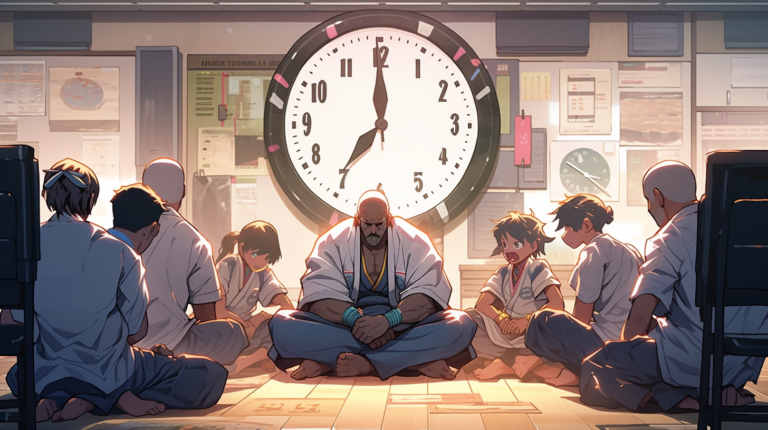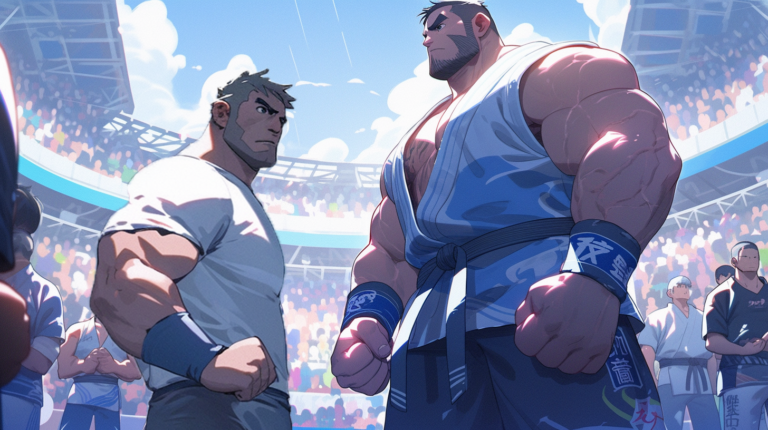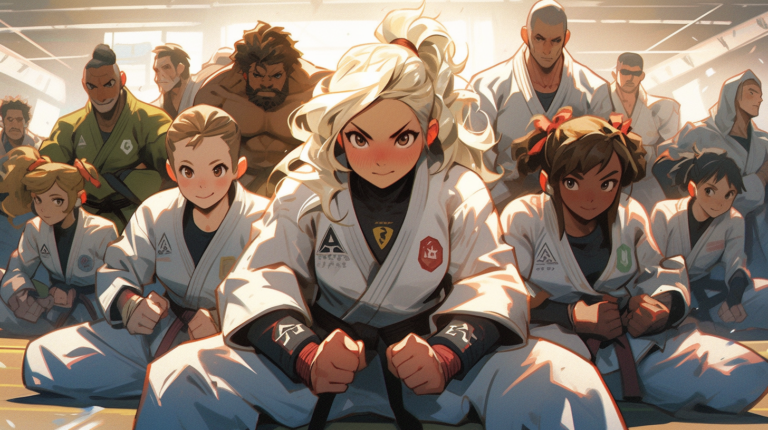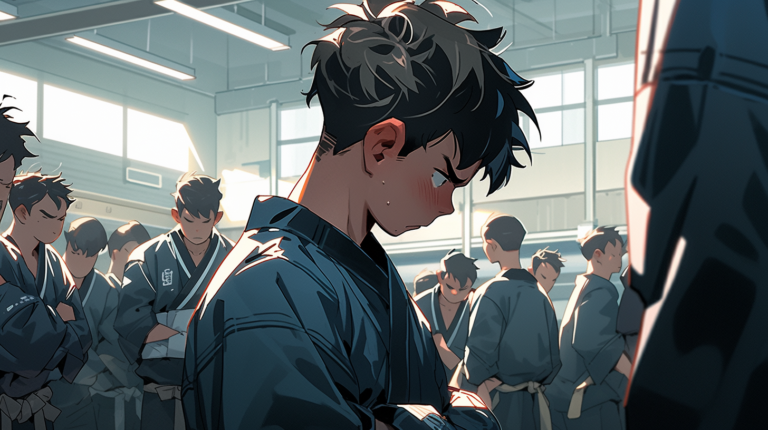how long does it take to learn jiu jitsu?: Understanding the Time it takes Learn
How long does it take to learn jiu jitsu?
Let’s answer this question “How long does it take to learn jiu jitsu?” Embarking on the journey of learning Brazilian Jiu-Jitsu is an endeavor that requires dedication, discipline, and perseverance. In this section, we will delve into the time it takes to become proficient in Jiu-Jitsu, focusing on the ultimate goal of earning a black belt. Strap on your gi and get ready to unravel the mysteries of this martial art. Let’s explore the path that lies ahead and the challenges that come with it.
Key Takeaway:
- The journey to becoming a black belt in Brazilian Jiu Jitsu typically takes around 10 years, although there are exceptions to this rule.
- There are three main learning styles in BJJ including drillers, rollers, and conceptuals, and combining these methods can lead to healthy game development.
- The effectiveness of conceptual BJJ can be seen in the time it takes to apply techniques practically.
- Consistent training is the key to improvement in BJJ, and finding success requires a commitment to regular and focused training.
- The basics of BJJ can be learned by overcoming initial ineptness, and the average time commitment to achieve a black belt is significant.
- Improvement in BJJ comes through a combination of drilling, rolling, and conceptualizing, and integrating all three elements is recommended.
- Training consistently is of utmost importance for progress in BJJ, and there are no shortcuts in the journey to mastery.
- The speed at which one learns BJJ can be affected by factors such as training frequency and practicing with other individuals.
- Brazilian Jiu-Jitsu is a martial art that emphasizes techniques, leverage, and ground fighting.
- The journey to a black belt in BJJ requires regular training and offers additional benefits such as self-defense skills, exercise, discipline, and a sense of community.
- Becoming proficient in BJJ takes time and effort, with mastery typically achieved at the black belt level.
how long does it take to learn jiu jitsu?: The Journey to a Black Belt
The path to a black belt in Brazilian Jiu Jitsu is both challenging and rewarding. It’s not uncommon for people to take 10 years to reach this goal, although exceptions exist. So how long does it take to learn jiu jitsu? That’s going to depend on your approach. Different learning styles can enhance BJJ skill development: drillers focus on technique repetition; rollers simulate fights and self-defense; and the conceptual approach it conceptually, emphasizing principles and objectives.
Combining these methods is essential for healthy game development. Drilling helps master movements, while rolling enhances timing and technique. Conceptualizing aids understanding of BJJ’s underlying principles. The author has experienced success with a combination approach.
Conceptual BJJ can be effective in application, but time needed varies. Consistency is key; success through consistent training leads to progress. Ineptness is a common obstacle, but dedicated practice can make strides.
On average, it takes 10 years of consistent training to get a black belt in BJJ. This timeframe is influenced by training frequency and another person. Mastering BJJ takes time, but there are additional benefits such as self-defense skills, exercise, discipline, and being part of a community.
Patience and commitment are needed to become good at BJJ. Embracing the journey without shortcuts is essential for long-term growth in this martial art. Beginner’s progress depends on natural ability and training consistency. Training frequency and practicing with someone are vital for developing practical skills.
Understanding the origins of Brazilian Jiu-Jitsu is important to fully grasp its elements: technique, leverage, and ground fighting. The journey to a black belt in BJJ requires consistent training and can have a significant impact on an individual’s progress. Along with skill development, practicing BJJ offers additional benefits such as self-defense training, physical fitness, discipline, and being part of a supportive community.
Becoming good at Brazilian Jiu-Jitsu takes time and dedication. Mastering this martial art usually takes many years of consistent training and practice. The path to earning a black belt is hard, but rewarding for those who embrace the journey with determination and perseverance. Who needs a ten-year rule? Tap out your doubts in half the time!
Exceptions to the 10-Year Rule
how long does it take to learn jiu jitsu? For Individuals with prior experience in disciplines like judo or wrestling you may have an edge in learning BJJ techniques, potentially shortening the time to reach a black belt level. The fast time that I know or have heard of is BJ Penn. Earning his black belt in 3 year. Some show exceptional athleticism and natural talent, progressing faster and mastering techniques quickly.
Intensive training regimes with multiple sessions daily or extensive periods of training can speed up the learning process. Professional athletes from related combat sports often have a high affinity for BJJ techniques, contributing to faster skill acquisition.
Effective coaching and mentorship from experienced instructors, along with innovative teaching methodologies, can help students reach higher proficiency faster. But, it still takes dedication, perseverance, and consistent training over years to get to a black belt level. Establishing a strong foundation by mastering the fundamentals is also important to prevent difficulties down the road.
Three Learning Styles in BJJ
In the realm of jiu jitsu, there are three distinct learning styles that practitioners embrace. Each style offers a unique approach to mastering the art. The drillers focus on perfecting techniques through repetition, while the rollers simulate real tournaments and self-defense scenarios. Lastly, the conceptuals adopt a point of view that emphasizes understanding the underlying concepts. By exploring these learning styles, we can better understand the diverse paths one can take in their journey to master jiu jitsu.
Drillers: Perfecting Techniques Through Repetition
Drilling techniques through repetition is a must for Brazilian Jiu Jitsu (BJJ) training. It helps with muscle memory, precision and understanding the moves. Repetition makes people more efficient and effective when rolling or competing.
Here is a 6-step guide to BJJ drilling:
- Choose a technique. Could be a submission, guard pass or sweep.
- Break it down into small components. To gain greater understanding of each movement.
- Focus on repetition. Do each step multiple times until it’s ingrained in your muscle memory. Pay attention to details too.
- Increase intensity. Gradually add resistance or speed up the technique.
- Test in live rolling. Apply the technique with different skill levels.
- Seek feedback and adjust. Get advice from instructors or experienced practitioners. Then make adjustments and keep refining.
It’s important to note there are other learning styles like simulating tournaments and self-defense. Combining repetition, rolling and conceptualizing approaches gives a well-rounded skill set.
To show the effectiveness of drilling repetition, consider John. He was a BJJ student who dedicated time to drilling and seeking feedback. John mastered complex movements and transitions in a short time. His dedication paid off and he became a formidable competitor. This shows the power of this approach for skill development in BJJ.
Rollers: Simulating Real Tournaments and Self-Defense Situations
Rollers in Brazilian Jiu Jitsu hone their techniques by engaging in simulated real tournaments and self-defense situations. This allows them to adapt to pressure and gain exposure to diverse styles. They test their techniques and strategies in a realistic setting, to increase their mental resilience. Simulated tournaments help them understand the competitive aspect of BJJ and develop strategies.
Rolling allows rollers to experience the intensity of live grappling matches, refine their techniques, and improve physical conditioning. It also provides a taste of real combative scenarios, thus enhancing their ability to defend themselves. Through rolling with different partners of varying skill levels and styles, rollers gain valuable insights into areas needing improvement.
Consistency is key for rollers to make progress. Training regularly over an extended period leads to steady growth in their abilities. Rolling is beneficial not only for competition-focused practitioners but also for those learning self-defense skills. It helps them develop a heightened sense of situational awareness and learn how to apply techniques under pressure.
In conclusion, rollers in Brazilian Jiu Jitsu can benefit from simulated real tournaments and self-defense situations. It helps them refine their techniques, adapt to pressure, gain exposure to various styles, and prepare for real-life combat scenarios. Moreover, understanding the underlying principles of BJJ is like unlocking the cheat codes to dominating opponents.
Conceptuals: Emphasizing a Conceptual Point of View
Focusing on the principles and theories behind BJJ techniques, rather than just repetition or simulation, is a concept known as emphasizing a Conceptual Point of View. This approach strengthens understanding and use of the art. It encourages practitioners to apply techniques creatively and gain a deeper insight into BJJ.
This approach examines the theoretical foundations of techniques and movements. It looks at leverage, technique, and ground fighting to create strategies. Instead of solely memorizing moves, conceptuals dive into the principles of BJJ, giving practitioners a broader view of how techniques work and why they are effective.
By focusing on concepts, practitioners can develop problem-solving abilities. It goes beyond learning individual techniques, by equipping practitioners with an understanding of fundamental concepts that work in different situations. It also encourages creativity and adaptability within BJJ, enabling students to make their own decisions based on sound principles.
My experience with BJJ supports this approach. As I prioritized a conceptual point of view, I saw improvements in technique and the ability to make game plans. Understanding key concepts like leverage and movement efficiency, helped me adapt techniques to different opponents and scenarios.
Overall, emphasizing a conceptual point of view is a valuable approach for BJJ practitioners. Combining drilling, rolling, and conceptualizing creates the perfect recipe for success on the mats.
Combining Methods for Healthy Game Development

Combining methods is crucial for healthy game development in jiu jitsu. We will delve into the importance of drilling, rolling, and concepts, as well as the author’s experience with a combination approach. Emphasizing these aspects leads to improved technique, adaptability, and overall growth in the practice of jiu jitsu.
The Importance of Drilling, Rolling, and Concepts
Drilling, rolling, and conceptualizing are key to Brazilian Jiu Jitsu. All three are vital to a strong game.
Drilling helps master moves through repetition and build muscle memory. Rolling simulates tournaments and self-defense, to hone timing and technique. Conceptualizing means understanding the principles and objectives, for a deeper understanding of the art. Combining all three is best for BJJ growth.
Drilling is about mastering movement with repetition. Practicing specific techniques helps refine execution and create muscle memory. It also lets individuals break down complex movements into components, to help them understand the mechanics.
Rolling bridges drilling and practical application. Through simulated sparring, practitioners test their skills against opponents, improving timing and adaptability. It is unpredictable which helps build quick decision-making and performance in live situations.
Conceptualizing is about understanding the principles and objectives of BJJ techniques. Rather than memorizing moves, it emphasizes grasping the concepts behind them. By learning principles like leverage, weight distribution, and body mechanics, practitioners can better understand how each technique works and how it can be applied.
For optimal BJJ, all three should be used. Drilling hones technical proficiency, rolling enhances practical application skills, while conceptualizing gives a broader perspective. Combining these creates a strong foundation and accelerates learning. The perfect mix of drilling, rolling, and conceptualizing is the key to success.
The Effectiveness of Conceptual BJJ
When it comes to the effectiveness of conceptual BJJ, one aspect we’ll explore is the time required for practical application. How long does it take to see real progress on the mats? In this section, we’ll delve into the factors that influence the learning curve of jiu jitsu and examine the timeframes involved in acquiring practical skills. By understanding the timeline of progress, we can gain insights into the effectiveness of conceptual BJJ in a practical context.
Time Required for Practical Application
To understand the time needed for practical application in Brazilian Jiu-Jitsu (BJJ), here is a five-step guide:
- Dedication to training is essential. Regular classes and drills help you learn.
- Mastering fundamentals is a must. Drilling sweeps, submissions, and escapes is important.
- Try different techniques in live rolling scenarios. Adapt to opponent’s reactions.
- Learn timing and technique from practice and observation.
- Continual learning is key. Seek out training partners to refine skills.
Progress in BJJ varies due to physical attributes, experience, and dedication. So, no exact timeframe exists. Dedication, mastering fundamentals, translating knowledge, understanding timing and technique, and continual learning are the keys to practical application in BJJ.
Consistency as the Key to Improvement
Consistency is the key to improvement in learning jiu jitsu. In this section, we’ll explore how consistent training can lead to success in the art of jiu jitsu, focusing on the importance of regular practice and dedication. By delving into the benefits of maintaining a consistent training routine, we can see the tangible progress and skill development that can be achieved in jiu jitsu.
Finding Success through Consistent Training
To learn Brazilian Jiu Jitsu, consistent training is essential. To master movements, drill. To improve timing and technique, roll. To understand principles and objectives, conceptualize. Combining all three elements helps to improve BJJ skills. Dedication and perseverance are also necessary for success. It’s not a short-term process – a long-term commitment is required. With regular training and commitment, proficiency in BJJ can be increased over time. The journey to learn BJJ is long, but with consistency and dedication, you will go from tapping out to rocking that black belt!
The Timeframe to Learn the Basics of BJJ
Overcoming initial ineptness and estimating the average time commitment to a black belt, explore the timeframe to learn the basics of BJJ. Discover how dedicated practice and consistent training can help you progress in this dynamic martial art.
Overcoming Initial Ineptness
- Have a Strong Mindset: Realize that everyone starts as a beginner and that growth happens with time and regular practice. Embrace the learning journey and be patient with yourself as you navigate the early stages.
- Master Basics: Getting a good handle on basic techniques is key for forming a strong base in BJJ. Spend time to learn and understand each technique, practicing them until they become instinct.
- Ask Experienced Practitioners for Help: Collecting advice from experienced teachers and training partners can provide valuable clues and corrections to your form. They can point out areas to improve and give advice on how to beat certain challenges.
- Train Consistently: Going to classes and putting in the required practice time is key to overcoming early ineptness. Consistency helps with creating muscle memory, understanding techniques better, and making steady progress.
- Welcome Failure as Part of Learning: Know that making mistakes and having setbacks are standard when starting something like BJJ. Accept these failures as chances to learn, develop, and refine your abilities.
By following these steps, beginners can get over their starting ineptness in Brazilian Jiu-Jitsu and ready themselves for future development.
It’s also important to note that each person advances at their own speed depending on factors like natural talent, commitment, training frequency, and fitness level. So, it’s essential not to compare yourself to others but instead focus on your own growth within Brazilian Jiu-Jitsu.
The Average Time Commitment to a Black Belt
The time needed to reach a black belt in Brazilian Jiu Jitsu can differ. It is clear that it takes effort and time to get there. Data shows that the 10-year rule for getting a black belt in BJJ is not always accurate. Different learning styles, like drilling, rolling, and conceptualizing, can be combined to help. Practicing consistently is key for getting better in BJJ.
Here is a table on the average time commitment to a black belt in BJJ:
| Factors Affecting Learning Speed | Average Time Commitment |
|---|---|
| Recommended Training Frequency | Varied |
| Importance of Practicing with Another Person | Necessary |
This table shows that the training frequency may vary and practicing with another person is important. These factors influence the overall time needed for a black belt.
It is important to note that it may take more time than expected to get good at BJJ and reach black belt level. The journey is long and no shortcuts can be taken. This journey is important to make sure progress is made.
The secret to improving in BJJ is having a well-rounded approach. This means using every technique.
Improving in BJJ: Drilling, Rolling, and Conceptualizing
To enhance your journey in Brazilian Jiu-Jitsu, it’s crucial to focus on three key elements: Drilling, Rolling, and Conceptualizing. In this section, we’ll explore how mastering movements through drilling, enhancing timing and technique through rolling, and understanding principles and objectives through conceptualizing can accelerate your progress. By combining all three elements, you can develop a well-rounded approach that will give you a competitive edge in the world of BJJ.
Mastering Movements through Drilling
Drilling is vital for mastering movements in Brazilian Jiu Jitsu (BJJ). Repetitive practice aids muscle memory and technique. Focus on specific movements and sequences to refine skills and execute better during live rolling and competitions. To get the most out of drilling, here’s a three-step guide:
- Start with the basics: Break down techniques into single movements or steps. Isolate each movement and focus on proper form, positioning, and execution. This builds a strong foundation.
- Repetition is key: Once the basics are learned, repeat each movement to reinforce muscle memory. Aim to make movements automatic and require less effort.
- Gradually increase complexity: As proficiency grows, add complex drills that involve multiple movements or techniques. This helps flow between positions and transitions.
To master movements through drilling, it requires consistent practice over time. Regularly dedicating time allows refinement, timing, and execution mastery. Here are some tips:
- Quality over quantity: Do fewer reps better with full concentration.
- Seek feedback: Get outside perspectives for corrections.
- Incorporate resistance: Gradually add resistance with training partners to simulate real-life scenarios.
Using these suggestions in drilling sessions accelerates progress and enhances learning in BJJ.
Enhancing Timing and Technique through Rolling
- Drilling, rolling, and conceptualizing are all key for honing timing and technique in Brazilian Jiu Jitsu.
- Drill techniques repeatedly to perfect movements and build muscle memory. This repetition helps build timing and coordination.
- Incorporate progressive rolling sessions. Start with controlled moves and gradually raise intensity. This allows practitioners to apply techniques and improve reaction time.
- Include positional training in rolling sessions. Focus on specific positions or situations to hone technique. This further enhances timing and technique development.
- After each rolling session, reflect and seek feedback. Identify areas for improvement and make adjustments. Get input from training partners or instructors to refine timing and technique.
- Consistently practicing these steps helps students enhance timing and develop effective techniques through rolling.
- Remember that drilling, rolling, and conceptualizing do not exist in isolation. They must work together to improve overall skills. This combination approach ensures well-rounded development in timing, technique, principles, objectives, movement mastery, and understanding concepts within BJJ.
Understanding Principles and Objectives through Conceptualizing
To grasp the principles of Brazilian Jiu-Jitsu, conceptualizing is key. It allows practitioners to analyze and interpret movements, leverage, and ground strategies. This enables them to create a strategic approach to BJJ. Through conceptualizing, they can refine their techniques and adapt them for different scenarios.
Understanding principles and objectives is an essential part of learning BJJ. Practitioners focus on understanding how techniques work, instead of memorizing specific moves. By breaking complex movements into core concepts, they can gain a comprehensive understanding of BJJ.
Conceptualizing also provides flexibility in executing techniques. Practitioners are not limited to rigid sequences or positions. They learn to adjust their movements based on the situation. This helps with problem-solving and strategy during live rolling or competitions.
In short, conceptualizing is a crucial part of Brazilian Jiu-Jitsu training. It helps practitioners develop a deeper understanding of the art. By embracing this approach, they can enhance their performance by applying principles and adapting their movements.
The Recommended Approach: Combining all Three Elements
The recommended approach in Brazilian Jiu Jitsu is to combine the three elements of drilling, rolling, and conceptualizing. This combination allows practitioners to develop skills and understand the sport.
Drilling perfects techniques through repetition. It builds muscle memory. Rolling simulates real tournaments and self-defense situations. And, it refines timing and technique. Conceptualizing provides a deeper understanding of the sport’s principles and objectives.
By combining these three elements, practitioners can enhance their overall game development. This approach has been proven effective by many practitioners who have experienced success in their journey to becoming black belts in BJJ. It promotes a well-rounded skill set and a comprehensive understanding of the sport.
The Importance of Training Consistently
Consistent training is key when it comes to mastering jiu jitsu. In this section, we’ll uncover the secret to improving in BJJ and how it’s directly tied to training consistently. Whether you’re a beginner or a seasoned practitioner, the importance of dedication and regular practice cannot be overstated. So, what does it take to truly excel in jiu jitsu? Let’s find out.
The Secret to Improving in BJJ
For Brazilian Jiu Jitsu (BJJ) to improve, it requires a combination of drills, rolls, and conceptualizing. These three styles of learning are essential for mastering BJJ techniques.
- Step 1: Drilling – Repetition Perfects
Drilling is repeating techniques to make them instinctive. Focusing on perfecting movements and sequences helps build muscle memory and refine BJJ techniques.
- Step 2: Rolling – Simulated Real Life
Rolling is live sparring that is like real tournaments or self-defense. It applies drilled techniques in an unpredictable setting and improves timing, adaptability and decision-making in BJJ.
- Step 3: Conceptualizing – A Conceptual Point of View
Conceptualizing is knowing the principles and objectives behind BJJ techniques. It focuses on understanding instead of memorization and improves problem-solving and innovation.
For improvement in Brazilian Jiu Jitsu, consistent training is key. The combination approach works for different learning speeds. It develops technique, timing, adaptability, and strategic thinking. History has shown that this combination approach is effective. It has taken practitioners from beginner to black belt level. If dedicated to consistent training without shortcuts, individuals can reach full potential in BJJ.
Embracing the Journey with No Shortcuts
Embrace the journey of learning Jiu Jitsu with no shortcuts and discover the timeline for beginners to master BJJ. Gain insights into the process of becoming proficient in this martial art, and understand the dedication required to progress through the ranks. So, how long does it really take to become skilled in Jiu Jitsu? Let’s delve into the timeframe for beginners and unveil the commitment needed to thrive in this dynamic discipline.
The Timeframe for Beginners to Learn BJJ
The time to learn BJJ can vary. But, usually it takes 10 years to get a Black Belt. Some may take less or more time. Consistent training and no shortcuts are needed.
Things that affect speed of learning BJJ:
- Recommended training frequency for beginners.
- Practicing with another person.
- Knowing the techniques, leverage, and ground fighting principles.
Various training methods help with healthy game development:
- Drilling perfects techniques with repetition.
- Rolling simulates real tournaments and self-defense situations.
- Conceptuals put a focus on a conceptual point of view.
All three methods have benefits.
Beginners should expect to spend some time learning BJJ. With dedication and consistent practice, they can progress at their own pace. Training frequency and practicing with someone help speed up learning. But don’t worry, it’s still easier than untangling your headphones!
Factors Affecting Learning Speed in BJJ
When it comes to learning jiu jitsu, understanding the factors that affect your learning speed is essential. In this section, we will explore two key aspects: the recommended training frequency for beginners and the importance of practicing with another person. By diving into these sub-topics, we can uncover valuable insights that will help you on your journey to becoming proficient in the art of jiu jitsu.
Recommended Training Frequency for Beginners
Consistency is key for BJJ beginners. Aim to train at least 2-3 times a week. Quality beats quantity. Increase training frequency as you become more confident and comfortable. Listen to your body and take rest when needed. Don’t push too hard; it can lead to injuries and hinder progress. Balance between consistency and recovery time is important.
Importance of Practicing with Another Person
Training with a partner in BJJ is essential to develop key skills and increase overall performance. This collaborative approach helps practitioners refine their techniques, boost their reflexes and timing, and gain a deeper insight into the principles of BJJ.
Drilling is key for perfecting moves and building muscle memory. This repetition leads to better technique execution.
Live rolling sessions enable practitioners to apply techniques under pressure, test their skills, and develop strategies. This realistic simulation ensures they are prepared for tournaments and self-defense situations.
Training with another person also provides a conceptual point of view. Through discussions, practitioners can comprehend the concepts behind techniques, thus becoming better problem solvers and more creative adaptors.
To advance in BJJ, practitioners must incorporate drilling, rolling, and conceptualizing into training. This comprehensive approach results in a well-rounded improvement in all aspects of Brazilian Jiu-Jitsu.
By regularly training with a partner, practitioners can learn more quickly and become proficient in BJJ techniques. Training with a partner also fosters a sense of community and creates a positive environment for personal growth. Don’t miss out – discover the technique, leverage, and ground fighting that make BJJ the ultimate self-defense art!
Understanding Brazilian Jiu-Jitsu and Its Origin
Brazilian Jiu-Jitsu, renowned for its technique, leverage, and ground fighting, has a rich origin that begs exploration. Unravel the fascinating world of BJJ as we delve into its roots and uncover the elements that make it a formidable martial art. Discover the transformative power of this discipline, as techniques are honed, leverage is maximized, and the art of ground fighting is mastered.
Technique, Leverage, and Ground Fighting as Key Elements
Technique, leverage, and ground fighting are important for Brazilian Jiu Jitsu (BJJ). BJJ focuses on using technique and leverage instead of strength and size. With the right technique, practitioners can control their opponents and get into a good position. Ground fighting is essential for BJJ, as it mostly happens on the ground. It uses grappling techniques and submissions.
Getting a black belt in Brazilian Jiu Jitsu is slow, like watching paint dry. Except you can get choked out!
The Journey to a Black Belt in BJJ
Embarking on the journey to a black belt in BJJ is no small feat. In this section, we’ll explore key aspects that shape this journey. From the impact of training frequency on progress to the wide array of additional benefits, such as self-defense skills, exercise, discipline, and being part of a supportive community, there is much to discover on the path to becoming a skilled practitioner of jiu jitsu.
Training Frequency and Its Impact on Progress
Training frequency is vital for progress in Brazilian Jiu Jitsu (BJJ). Regular training has a major effect on improving skills and mastering techniques. The more often people practice, the quicker they are likely to progress.
Here’s a 5-step guide on how training frequency impacts BJJ progress:
- Consistency: Going to training sessions regularly allows people to build and strengthen their skills. Through consistent practice, they form muscle memory, helping them do techniques accurately during matches or self-defense.
- Reinforcement: Frequent training provides many chances to reinforce understanding of BJJ techniques. Doing drills and exercises repeatedly improves muscle memory and improves performance.
- Skill development: Increasing the frequency of training helps individuals refine their skills faster. By spending more time learning new techniques and perfecting existing ones, they can speed up progress and move up belt ranks quickly.
- Adaptability: Regular practice lets people adjust to different opponents’ styles and strategies. By facing various sparring partners, they learn to react appropriately in different situations, increasing their ability to think tactically in matches or self-defense.
- Physical conditioning: Training not only boosts technical skills but also physical fitness. BJJ demands strength, endurance, agility, and flexibility. Regular training helps practitioners build these qualities over time, improving overall performance.
Progress varies depending on factors such as natural aptitude, prior martial arts experience, commitment level, and instruction quality. But consistent training is still a major factor in determining how fast and far people progress in Brazilian Jiu Jitsu.
Besides regular training, it is suggested to join seminars, workshops, and competitions to further enhance skills and knowledge. These offer valuable tips from experienced practitioners and a chance to use learned techniques in a competitive setting.
By combining consistent training with extra learning opportunities, people can maximize their BJJ progress and work towards their goals.
Additional Benefits: Self-Defense, Exercise, Discipline, and Community
BJJ offers many benefits beyond self-defense. Exercise, discipline, and a sense of community are just some of them.
- Self-Defense: BJJ teaches useful self-defense skills.
- Exercise: Training is physically demanding, giving you an effective workout.
- Discipline: It takes discipline and dedication to learn the techniques and principles of BJJ.
- Community: You can create strong bonds with the other practitioners, and make friends for life.
Each person’s experience of BJJ may bring additional positive outcomes. Take John for example. His fellow practitioners gave him the motivation he needed to push himself and grow as a person. Through his journey in BJJ, John gained lifelong friendships that still inspire him in his pursuit of mastery. The road to BJJ excellence is long, but worth it.
The Timeframe to Become Good at BJJ
To truly master the art of Brazilian Jiu-Jitsu (BJJ) and reach the coveted black belt level, the journey is not measured in mere weeks or months. It takes dedication, perseverance, and countless hours on the mat. In this section, we will explore the timeframe required to become proficient in BJJ and delve into the significance of achieving mastery and obtaining the black belt. So, let’s strap on our gi and dive into the transformative journey of learning BJJ.
Mastery of BJJ and the Black Belt Level
Mastering BJJ and achieving a black belt requires dedication and effort. It’s a journey involving different learning techniques, such as drilling, rolling, and conceptualizing. Combining these is key for developing skills in BJJ.
Drilling focuses on perfecting movements through repetition. Rolling simulates real matches and self-defense. Conceptualizing involves understanding principles and objectives.
For success in BJJ, it’s important to train regularly. This helps overcome initial ineptness and can take 10 years of consistent training to achieve a black belt.
Conceptual BJJ’s practical use lies in combining all three elements – drilling, rolling, and conceptualizing. Training frequency for beginners affects learning speed. Practicing with someone else is beneficial for applying techniques realistically.
Brazilian Jiu-Jitsu originated from technique, leverage, and ground fighting. It offers numerous benefits like self-defense, exercise, discipline, and community.
Achieving mastery in BJJ depends on individual dedication. There’s no shortcut or set timeframe, but regular training with the right approach leads to progress.
Some Facts About How Long It Takes to Learn Brazilian Jiu Jitsu:
- ✅ Brazilian jiu jitsu takes around 10 years to achieve a black belt, with some exceptions like BJ Penn and Kit Dale who have rapid rises. (Source: Team Research)
- ✅ There are three learning styles in BJJ: drillers, rollers, and conceptuals. (Source: Team Research)
- ✅ Drillers focus on perfecting each technique through repetition, but it can be time-consuming. (Source: Team Research)
- ✅ Rollers prefer to simulate real tournaments or self-defense situations by doing rounds with resisting opponents. (Source: Team Research)
- ✅ Conceptuals look at movements or objectives from a conceptual point of view, reducing the need for extensive drilling. (Source: Team Research)
FAQs about How Long Does It Take To Learn Jiu Jitsu?
How long does it take to learn jiu jitsu?
How long does it take to learn jiu jitsu? Learning jiu jitsu is a continuous process that takes time and dedication. On average, it takes about 10-15 years to earn a black belt in jiu jitsu. However, the time it takes to become proficient and “good” at jiu jitsu varies from person to person. Some individuals, like BJ Penn and Kit Dale, have achieved rapid success, while others may take longer.
What is the best approach to learning jiu jitsu?
The best approach to learning jiu jitsu is to combine all three main methods: drilling, rolling, and conceptualizing. You approach is will directly effect how long does it take to learn jiu jitsu. Drillers focus on perfecting techniques through repetition, rollers simulate real tournaments or self-defense situations, and conceptuals understand the principles and objectives of techniques. A combination of these methods is essential for overall healthy game development.
How often should I train to improve in jiu jitsu?
Consistency is key in jiu jitsu training. It is recommended to attend training sessions regularly, preferably 3-4 times per week. For those who want to compete or become highly skilled, training at least 5 times per week is recommended. Training regularly and consistently will help improve your skills and progress in jiu jitsu.
Is It Possible To Learn Jiu Jitsu For Self-Defense?
Yes, jiu jitsu is an effective martial art for self-defense. Learning jiu jitsu for self-defense or street fighting can take many years due to the complexity of the discipline. It involves understanding techniques, positions, and submissions to effectively defend yourself in real-life situations. Consistent training and a solid understanding of jiu jitsu principles are key in learning it for self-defense.
Can Anyone Learn Jiu Jitsu, Regardless Of Age Or Gender?
Absolutely! Jiu jitsu classes are open to everyone, regardless of age or gender. It is a martial art and combat sport suitable for individuals of all backgrounds and fitness levels. Jiu jitsu promotes personal growth, discipline, and a strong sense of community, making it accessible to anyone who is willing to learn and train.
What Are The Additional Benefits Of Training In Jiu Jitsu?
Training in jiu jitsu offers various benefits beyond learning self-defense. It improves physical fitness, promotes self-discipline, builds confidence, and provides opportunities to be part of a supportive community. Jiu jitsu also enhances mental health, problem-solving skills, and critical thinking. It offers a holistic approach to personal development while learning a highly effective martial art.







